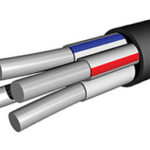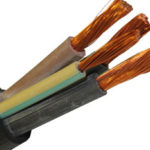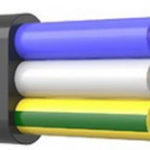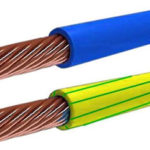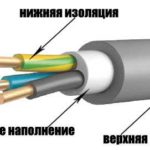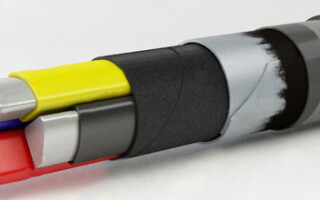Due to its high technical performance and design features, operational reliability and long service life, the AVBBSHV cable has become one of the most common power conductors. It is used when connecting stationary installations and transformers.
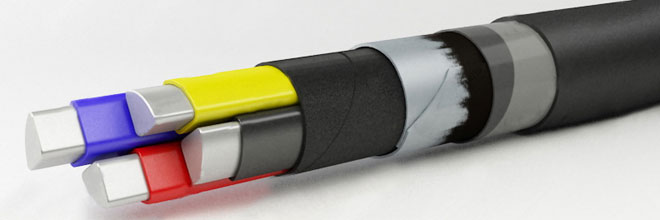
Content
Design and technical characteristics of the cable AVBBSHV
The basis of any electrically conductive element is a metal core, and the AVBBSHV power cable is no exception. The first letter "A" in the marking of the wire indicates that it is based on a conductive conductor made of aluminum. The main advantages of such cable products are low cost and light weight.
Conductors can be single-wire or multi-wire, and their shape can be round or sector.
If the conductor design provides for the presence of several cores (from 1 to 3), then they will all have the same cross section.A four-core cable contains a zero core, the cross section of which is smaller than the others.
In order to prevent a short circuit between the conductors, a special PVC sheath is provided in the conductor design. Sheath resistance can vary from 7 to 10 MΩ/km, depending on the wire cross section.
The color of the insulating shell has the following meanings:
- grounding - yellow-green;
- zero - blue;
- the main cores can be painted in other colors.
In some cases, the shells may have an encoding of values (numbers from zero or more).
All cores are located close to each other, and the free space between them is filled with PVC compound. If the power cable has a small cross section, then filling is not used.
The interlacing of cores is protected by two PET tapes. From above, all this is wrapped with a steel tape, which performs the function of armor, reliably protecting the product from mechanical external influences. It is immediately worth clarifying that this tape does not save from stretching. In some types of power conductors, a bituminous layer is used instead of a steel tape.
The outer sheath is made of PVC. Such a solution protects the wire from fire when laid alone.
AVBBSHV cable specifications:
- allows heating of conductors up to +70°С;
- the circuit occurs when the conductor is heated to + 160 ° C;
- working range of ambient temperature -50…+50°С;
- the minimum air temperature at which laying is allowed is -15 ° С;
- warranty - 5 years;
- operational resource (service life) - 30 years;
- voltage - 660/1000 V;
- operation in emergency mode is 8 hours a day and 1000 hours for the entire period of operation;
- frequency - 50 Hz.
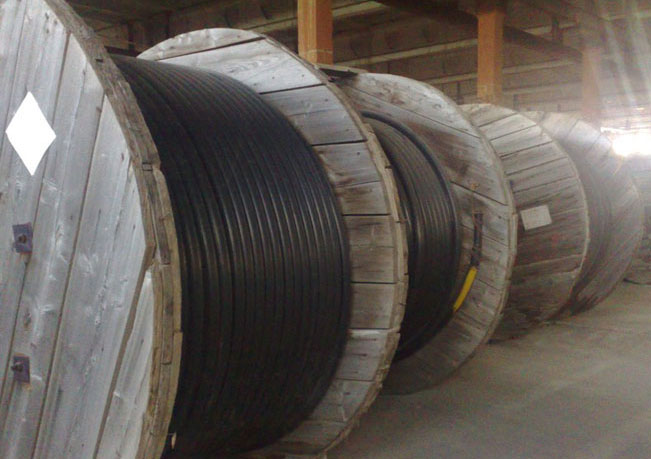
How to decipher the marking
On the outer insulation, each manufacturer applies product markings. For this, a special printer or a hot stamping method can be used. The marking decoding designation is standard, corresponds to GOST.
Cable decoding AVBBSHV:
- "A" - the core is made of aluminum;
- "B" - applied PVC insulation;
- "B" - booking using steel tapes;
- "b" - the absence of a protective cushion between the cores and the armor;
- "Shv" - the outer sheath of PVC hose.
The description following the letters is deciphered as the number and size of the cross section of the cores. For example, 3x35 indicates the presence of three cores, each of which has a cross section of 25 mm². An additional value is allowed: 3x25 + 1x16. This means that the conductor uses 3 main cores and 1 neutral circuit with a cross section of 16 mm².
Operating conditions
The technical characteristics of the AVBBSHV cable are designed for its overground and underground operation. Due to the presence of armor, the wire is able to withstand pressure from the ground. But this is true only under the condition of low corrosive activity of the latter. Also, during the installation process, it should be borne in mind that the cable is susceptible to tensile forces.
No less actively the wire is used in tunnels, mines and other premises. It is allowed to use the cable in open areas. The laying line must be stationary with a vertical, inclined or horizontal arrangement. The humidity level should not exceed 90%, and the operating temperature indicators are indicated in the technical characteristics of the cable.
bending radius:
- 10 diameters for a single-core wire;
- from 7.5 diameters for the stranded version.
The length of the cable during construction can be 350-450 m, depending on the cross-section of the conductors.
Application area
Scope AVBBSHV is focused on the arrangement of electrical mains (with voltage up to 10 kV) in civil and industrial construction, designed to connect stationary installations.
AVBBSHV-cable has the main characteristics that allow laying under the following conditions:
- at an altitude not exceeding 4000 m;
- at facilities where periodic flooding is possible;
- underground;
- in tunnels;
- inside different types of premises;
- at fire and explosive facilities;
- on power lines.
The presence of a layer of steel tape, as well as several layers of PVC insulation of different densities, significantly expanded the scope of the cable. For the arrangement of power transmission lines, a power conductor with additional protection from a bitumen layer is used.
This conductor can be used in the private sector. It will be especially appropriate for the arrangement of outbuildings and underground utilities.
The manufacturer does not recommend using aluminum cable for laying electrical wiring in the house, however, this is not a ban on its use for this purpose. It's all about the low price. A copper analogue can cost 4 times more, while the technical and operational parameters of both options are almost identical.
Similar articles:
